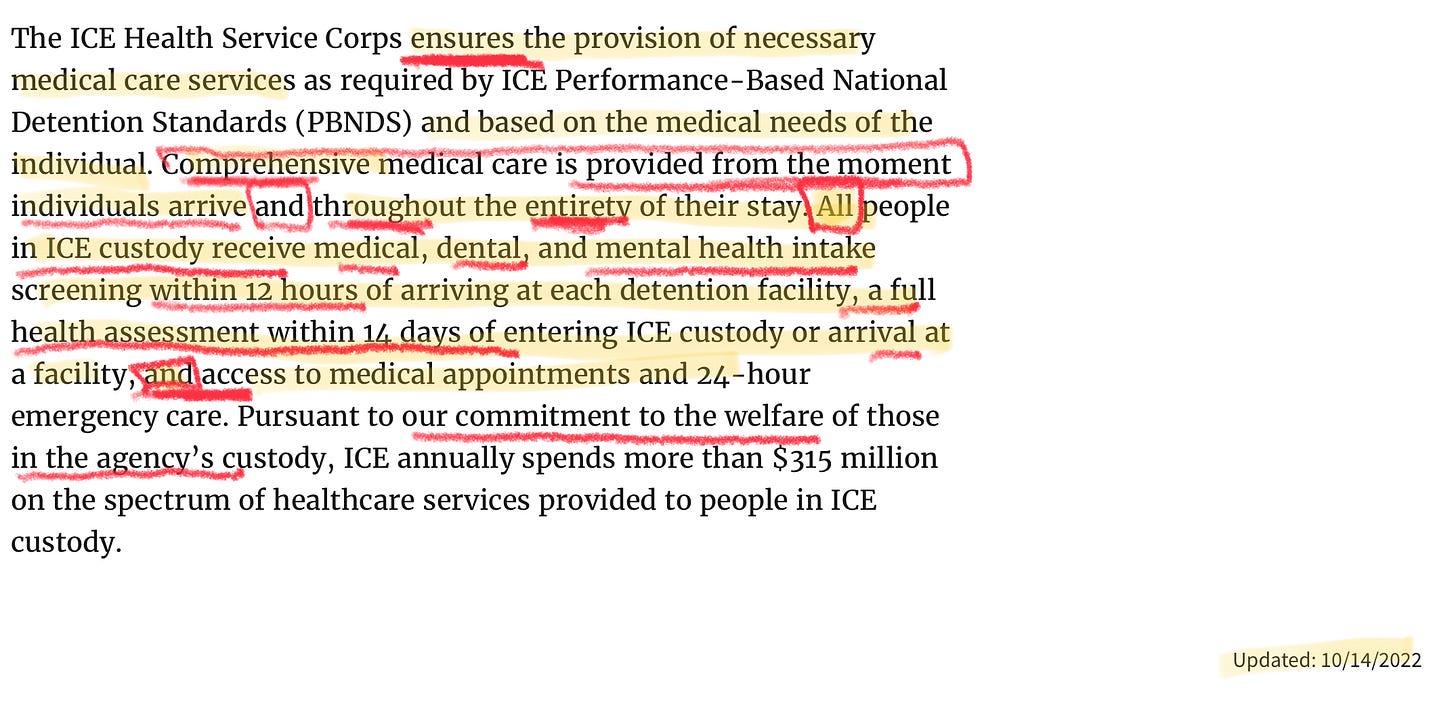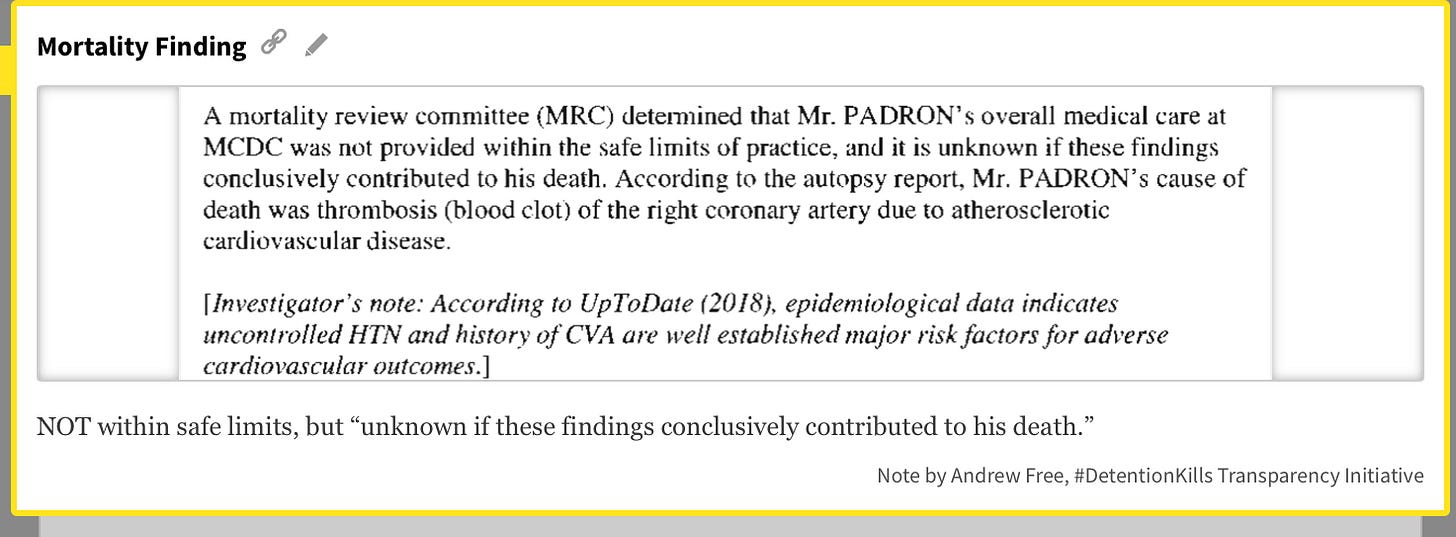“. . . from the moment individuals arrive . . .” #DetentionKills Transparency Initiative FOIA Journal v. 2022-4
ICE’s secret Death Reviews contradict its boilerplate Death Press Releases.
“We tell ICE’s story.”
- ICE Office of Public Affairs Landing Page, (last accessed Nov. 13, 2022)
When people die in U.S. Immigration and Customs Enforcement (ICE) custody and sometimes (but not always) shortly thereafter, the agency’s press office announces the tragedy in a press release. Most recently, on October 14, 2022, ICE announced the death of Melvin Ariel Calero Mendoza, a 39 year-old father of two who fled Nicaragua (a country whose electoral process President Biden called a “sham” last year) seeking asylum. He could not afford the cash bail U.S. officials demanded he pay to buy his freedom, so Melvin’s life ended in custody.
Melvin is the second Nicaraguan asylum-seeker to die in ICE custody in less than 16 months. His marked the 55th ICE press release since the birth of our project with the death of Jean Jimenez on May 15, 2017. That’s a little less than 11 deaths every year in the five years since. Meaning someone died in ICE custody around an average of 11 months a year, every year since. We’ll revisit rhetorical violence and cognitive anchoring inherent in a message’s choice of denominator shortly.
For now, what this means is that when it comes to deaths in ICE custody, ICE’s Office of Public Affairs (OPA) has had to figure out at least 55 times since May 2017 about how to “tell ICE’s story.”
How often is “ICE’s story” true?
How often should we expect it to be?
What happens when ICE finds out its records contradict its story?
Do the families of people who die in ICE custody have a right to know ICE’s conclusions without dragging the agency into court?
We think these are questions worth asking.
So we did.
ICE’s Story
ICE’s press release announcing Melvin’s death at the Aurora ICE Processing Center, operated by The GEO Group, Inc. ($GEO), makes some pretty sweeping assertions.
For present purposes, we’ll focus on the three most glaring:
ICE Health Services Corps (IHSC) “ensures the provision of necessary medical care services . . .”
“All people in ICE custody receive medical, dental, and mental health intake screening within 12 hours of arriving at each detention facility, a full health assessment within 14 days of entering ICE custody or arriving at a facility, and access to medical appointments and 24-hour emergency care.”
Not “strives to ensure”; “ensures.”
Not “is expected to be provided” or “is generally provided, when feasible”; “is provided”.
Not, “Nearly all people” or “All people . . . are expected to receive . . .”; “All people . . . receive.”
These are choices about how OPA is going to “tell ICE’s story.” ICE OPA made them for a reason.
ICE’s Other Story
The story ICE Health Services Corps (IHSC) tells is vastly different, according 13 Mortality Reviews from ICE’s own secret, internal IHSC Mortality Review Committee (MRC), as documented in records ICE’s Freedom of Information Act (FOIA) Office recently released in response to a May 2019 FOIA request.
To categorize what the secret death reviews say, we compare the two inter-related data points the MRC includes in the “Mortality Finding” it made for each person’s death:
First, can the agency conclude the medical care the deceased person received at the facility was “within safe limits of practice? Second, did the care directly or indirectly contribute to the person’s death?
Where the MRC concludes care was within safe limits of practice and did not directly or indirectly contribute to death, it says so unequivocally, as in Ronal Francisco Romero’s case, which we wrote about here:
Where the MRC is unable to call the care “within safe limits of practice,” but finds it is unable conclude whether that contributed to the person’s death, it says that, too:
Sometimes, the MRC comes perilously close to adopting the conclusion that stands in the name of our project:
“The stress caused by Mr. Gonzalez being detained, not being able to contact his consulate, his STI, and his which of Nicaragua . . . may have reactivated the HSV, which led to schizophrenia and consequently to suicide.”
That’s a lot of words that sort of boil down to #DetentionKills.
Unlike ICE’s Press Office in its post-Death press releases, we’re going to show our work and tell you how we came to this conclusion. For each question (“within safe limits” and “contributed to death”) we coded all 13 Mortality Reviews into two binaries. For the safe limits category, we divided reports in which the MRC made unequivocal, affirmative findings that care was within safe limits vs. those where the MRC can’t conclude that. For the contributed to death category, we did the same.
Next, we look to see whether, even when ICE’s secret MRC process found care within safe limits that didn’t contribute to death, the Committee nonetheless found violations of standards or practices or rules that would be inconsistent with the sweeping ICE death press release statements.
ICE’s Story vs. ICE’s FOIA Responses
Here’s what we found:
All cases - 13 of 13 people (100%)’s - included PBNDS or other care violations, which ICE calls “weaknesses.”
Most cases - 8 of 13 (61.5%) - left ICE unable to conclude the care provided was “within safe limits.” In other words, ICE couldn’t call care “safe” in about 3 out of every 5 deaths.
In 8 of 13 cases, the MRC could not conclude that the care people who died in ICE custody received was “within safe limits of practice.”
In all 5 cases where the Committee reached the opposite conclusion, it noted deviations from ICE policies and standards of care. In 3 of those 5 cases, ICE declined to seek and review findings of independent experts and family members that contradicted or undermined the secret MRC’s findings.
Most cases - 8 of 13 (61.5%) - left IHSC’S MRC unable to conclude or state affirmatively that the care people received in detention did not contribute directly or indirectly to their deaths. In other words, the care people receive could have contributed directly or indirectly to their death.
The thirteen IHSC Mortality Reviews could have remained secret forever. ICE has never affirmatively presented them to a family, as far as we are aware. And getting them without litigation took years. FOIA is the engine that generates the real story. Getting this secret story shouldn’t require years of waiting, or protracted litigation, for families of people who perish in ICE custody and the communities who rally together to support these families, and everyone still inside and at risk. It should be the law. ICE should affirmatively post these Mortality Reviews online.
Oh wait. That is the law. Where three or more FOIA requestors seek the same documents, ICE must post them online in its FOIA Reading Room. (Some might call that the Beetlejuice! Provision of FOIA).
But if you review ICE’s FOIA Reading Room, you’ll find ICE stopped posting extensive detainee death documentation during the previous administration. You’ll also search in vain for ICE’s FOIA logs from the same period, which it previously disclosed affirmatively, and which would tell us if three requestors have already sought this info.
Not only is ICE telling a story that doesn’t match its secret mortality review records, it’s violating the law that requires the agency to post the records showing the stories don’t match, or telling us who’s already received those records.
Particularly in cases where people died, which are the people whose experiences are most relevant to the public, media, lawmakers, courts, and the market in reviewing ICE’s death press releases, ICE’s Story doesn’t add up. Given this history, we now might understand why 30 years—not the past 5—and Aurora—not the entire ICE detention system—are the denominators ICE chose for Melvin’s release.
If the sweeping statements in ICE’s post-death releases aren’t consistent with ICE’s own post-death Mortality Review findings, how “comprehensive” could the “agency-wide” have been? The one ICE says it conducts in the wake of all deaths?
ICE hasn’t always made these sweeping statements in post-death press releases. It dared not do so in Roger Rayson’s death announcement. In that case, the agency’s secret death review committee could not even rule out homicide as a cause of Mr. Rayson’s death. Read every word of that Mortality Review and you’ll see why.
The agency should correct its misstatements publicly, and apologize to families for the harm they cause. We’re not holding out hope. Because to tell the true story is to acknowledge: #DetentionKills.
Coming back to our questions from above, in light of the records:
How often was ICE’s story true?
0 of 13 Mortality Reviews (0%) matched ICE’s sweeping statements about medical care.
How often should we expect it to be?
That largely depends on what we believe the agency’s function is, and what it should be. You, individually, and we, collectively, must decide for our ourselves. That’s democracy. We get to tell ICE’s story, too.
What happens when ICE finds out its records contradict its story?
Apparently nothing.
Do the families of people who die in ICE custody have a right to know ICE’s conclusions without dragging the agency into court?
Yes. And they shouldn’t have to wait years for the government to honor it.
If you’ve gotten this far, please consider donating to help Melvin’s family through this difficult time. Heaven knows that support is not coming from the storytellers.









